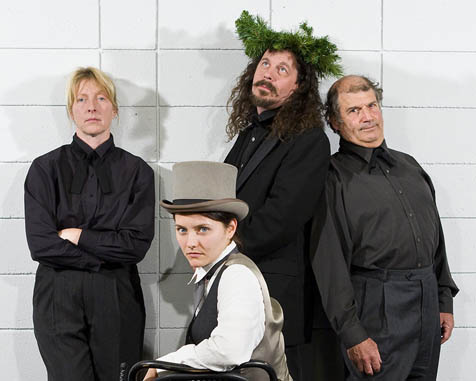Humbug! A (Lit Moon) Christmas Carol
At Center Stage Theater, Friday, December 21.

It is remarkable how simple stagings so often make for interesting and entertaining presentations. When the set is too elaborate, it draws attention away from the actors and their words. Distraction from the acting and Charles Dickens’ words was never a problem for John Blondell’s Humbug!, a unique adaptation of A Christmas Carol. Two of the actors, Stanley Hoffman and Victoria Finlayson, were already seated on the stage as the audience walked in. The five actors participating in the play-Finlayson and Hoffman, along with Erin Brehm, Kate Louise Paulsen, and Jim Connolly, who wrote and played the musical score as well-represented more than 20 characters between them. The simple, effective set consisted of several chairs and a large wooden table that also served as Scrooge’s bed. Using these and few other props, the cautionary Christmas tale of Ebenezer Scrooge was told.
The only thing Scrooge hates more than happiness or love is Christmas-a ghastly combination of the two. To show him the error of his hardhearted ways, three spirits visit Scrooge just before Christmas day. They are the ghosts of Christmas Past, Christmas Present, and Christmas Yet to Come. Scrooge’s travels through the past, present, and future show him that there is more to life than the cold, metallic gloom in which he has been residing. After seeing his mistakes, the plight of others, and his possible fate, Scrooge awakens Christmas morning completely changed and ready to do all he can for those around him.
Connolly’s great modern music and sound effects, Theodore Michael Dolas’s excellent lights, and Jaco Connolly’s wonderful paper puppets all told as much of the tale as the actors themselves and offered the audience a number of unconventional ways into the familiar story. When the puppets were used to portray Tiny Tim’s family, the Cratchits, the audience was thoroughly engaged by both humor and pathos. When Scrooge traveled through the town where he once lived, he looked and commented upon each tiny building the actors placed on the table, exactly as he had described it. But in the end, it was the marvelous actors and their great enthusiasm that brought the story to life. They were gleeful in one scene, dour in another, and each portrayed many characters without artifice. First published in 1843, A Christmas Carol retains its message of redemption when shown through a modern lens.



